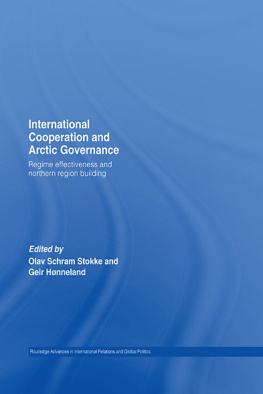Stokke Olav SchramOberthür Sebastian. (editor) - Managing Institutional Complexity
Here you can read online Stokke Olav SchramOberthür Sebastian. (editor) - Managing Institutional Complexity full text of the book (entire story) in english for free. Download pdf and epub, get meaning, cover and reviews about this ebook. year: 2011, publisher: MIT Press, genre: Politics. Description of the work, (preface) as well as reviews are available. Best literature library LitArk.com created for fans of good reading and offers a wide selection of genres:
Romance novel
Science fiction
Adventure
Detective
Science
History
Home and family
Prose
Art
Politics
Computer
Non-fiction
Religion
Business
Children
Humor
Choose a favorite category and find really read worthwhile books. Enjoy immersion in the world of imagination, feel the emotions of the characters or learn something new for yourself, make an fascinating discovery.
- Book:Managing Institutional Complexity
- Author:
- Publisher:MIT Press
- Genre:
- Year:2011
- Rating:3 / 5
- Favourites:Add to favourites
- Your mark:
- 60
- 1
- 2
- 3
- 4
- 5
Managing Institutional Complexity: summary, description and annotation
We offer to read an annotation, description, summary or preface (depends on what the author of the book "Managing Institutional Complexity" wrote himself). If you haven't found the necessary information about the book — write in the comments, we will try to find it.
Managing Institutional Complexity — read online for free the complete book (whole text) full work
Below is the text of the book, divided by pages. System saving the place of the last page read, allows you to conveniently read the book "Managing Institutional Complexity" online for free, without having to search again every time where you left off. Put a bookmark, and you can go to the page where you finished reading at any time.
Font size:
Interval:
Bookmark:
Managing Institutional Complexity
A Core Research Project of the International Human Dimensions Programme on Global Environmental Change (IHDP)
Oran R. Young, Leslie A. King, and Heike Schroeder, eds.,
Institutions and Environmental Change: Principal Findings, Applications, and Research Frontiers (2008)
Frank Biermann and Bernd Siebenhner, eds.,
Managers of Global Change: The Influence of International Environmental Bureaucracies (2009)
Sebastian Oberthr and Olav Schram Stokke, eds.,
Managing Institutional Complexity: Regime Interplay and Global Environmental Change (2011)
Managing Institutional Complexity
Regime Interplay and Global Environmental Change
edited by Sebastian Oberthr and Olav Schram Stokke
Institutional Dimensions of Global Environmental Change
A Core Research Project of the International Human Dimensions Programme on Global Environmental Change (IHDP)
The MIT Press
Cambridge, Massachusetts
London, England
2011 Massachusetts Institute of Technology
All rights reserved. No part of this book may be reproduced in any form by any electronic or mechanical means (including photocopying, recording, or information storage and retrieval) without permission in writing from the publisher.
For information about special quantity discounts, please email .
Library of Congress Cataloging-in-Publication Data
Managing institutional complexity : regime interplay and global environmental change / edited by Sebastian Oberthr and Olav Schram Stokke.
p. cm.(Institutional dimensions of global environmental change)
Includes bibliographical references and index.
ISBN 978-0-262-01591-2 (hardcover : alk. paper)
ISBN 978-0-262-51624-2 (pbk. : alk. paper)
ISBN 978-0-262-29743-1 (retail e-book)
1. Environmental policyInternational cooperation. 2. Climatic changesInternational cooperation. 3. Global warmingInternational cooperation. 4. Environmental law, International. I. Oberthr, Sebastian. II. Stokke, Olav Schram, 1961
GE170.M36 2011
363.73874561dc22
2010054079
10 9 8 7 6 5 4 3 2 1
Foreword
Oran R. Young
During the preparation of the Science Plan for the long-term project on the Institutional Dimensions of Global Environmental Change (IDGEC) in 1997 and 1998, we spent a lot of time discussing what emerged as the projects analytical themes, or the set of topics we deemed ripe for a major research push over a period of five to ten years. The themes we selected became known in the research community as the problems of fit, interplay, and scale (Young et al. 1999/2005). The problem of fit is a matter of compatibility between the features of institutional arrangements or governance systems and the character of the socioecological systems they are designed to manage. The problem of interplay concerns interactions between and among regimes created to address specific issues, such as climate and trade, that belong to separate issue areas. The problem of scale is a matter of the generalizability of findings relating to governance systems in the dimensions of space, time, and authority. As the synthesis volume we produced to record the most important results of IDGEC research makes clear, the project played a significant role in advancing knowledge regarding all three of these analytical themes (Young, King, and Schroeder 2008).
The stream of research that IDGEC triggered relating to institutional interplay or interactions among governance systems has proved particularly robust. In the IDGEC Science Plan, we drew simple distinctions between horizontal and vertical interplay and between functional and political interplay. This yielded a 2 2 matrix pointing to four different types of interplay. The matrix proved sufficient to trigger a growing and increasingly sophisticated body of research on institutional interplay. I am happy to report that it also led a number of researchers, including the editors of this volume, to raise probing questions about the formulation included in the IDGEC Science Plan and to experiment with new and improved ways to frame some of the important research questions pertaining to interplay. This sort of critical but constructive analysis exemplifies the best traditions in scientific research, and the results have broadened and deepened our understanding of this important subject.
One major finding of the stream of recent research on institutional interplay is that interactions between regimes can produce mutually beneficial and even synergistic results (Oberthr and Gehring 2006). Although intuitively this may not seem surprising, it is worth noting that much of the initial interest in interplay arose from a concern that the rapid growth in the number of international regimes would trigger a substantial increase in conflicts in this realm. The prospect of tensions and even open conflict between the global trade regime and various multilateral environmental agreements undoubtedly fueled this concern. But as the work of scholars such as Thomas Gehring and Sebastian Oberthr has made clear, conflict is by no means inevitable in this realm. Others have shown that regimes often occupy distinct niches, performing tasks such as building knowledge, creating norms, enhancing capacity, and enforcing compliance (Stokke 2007). This means that, at least in some cases, distinct regimes may develop in a manner that is complementary rather than conflictual.
This book, which is one of the last of the scientific products directly attributable to the IDGEC project, carries this stream of research forward with chapters that report on the latest findings of cutting-edge research regarding institutional interplay. Although each of the chapters has its own story to tell, the editors have done an excellent job in showing how, in aggregate, they shed substantial light on two prominent themes, interplay management and institutional complexes. Interplay management refers to conscious efforts on the part of those associated with distinct regimes or those approaching these matters in more synoptic terms to enhance positive interactions and minimize interference between and among regimes. This theme will surely increase in prominence in the near future. Institutional complexes arise when two or more distinct regimes generate interlocking governance structures relating to broad issue areas (e.g., climate, biodiversity) and coevolve in such a way as to produce emergent properties. The emergence of such complexes, whether they represent planned developments or reflect de facto trends, is another phenomenon that is of growing significance in a world in which both the number and the variety of international regimes are on the increase.
The importance of institutional interplay is destined to grow as more and more issues appear requiring governance systems that are transboundary, international, or global in scope. There is nothing surprising about this. It is a matter that has long been familiar to policymakers and researchers studying political institutions in domestic settings, who have introduced concepts such as conflict of laws to organize thinking about institutional interplay and have developed judicial procedures to sort out complications that arise when two or more sets of rules or regulatory arrangements address the same issue area. At the international level, where there is no government or public authority in the ordinary sense of the term, there is a need to make use of procedures that focus more on the role of negotiation to minimize conflict and encourage synergy among interacting regimes. This will put a premium on the conduct of policy-relevant research designed to provide the knowledge needed by those responsible for such negotiations. The quality of the chapters in this book provides grounds for optimism regarding the capacity of the research community to rise to this challenge. The best tribute to the success of this volume will be its ability to stimulate an ongoing stream of research on institutional interplay that will not only extend some of the findings reported in these chapters but will also open up new questions that will provide opportunities for contributions from the next generation of analysts interested in institutional interplay.
Next pageFont size:
Interval:
Bookmark:
Similar books «Managing Institutional Complexity»
Look at similar books to Managing Institutional Complexity. We have selected literature similar in name and meaning in the hope of providing readers with more options to find new, interesting, not yet read works.
Discussion, reviews of the book Managing Institutional Complexity and just readers' own opinions. Leave your comments, write what you think about the work, its meaning or the main characters. Specify what exactly you liked and what you didn't like, and why you think so.












